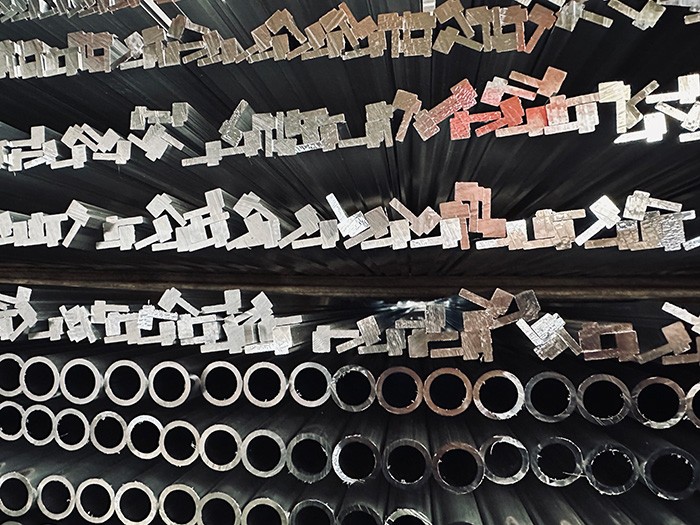Series 1
Alloys like 1060, 1070, 1100, etc.
Characteristics: Contains over 99.00% aluminum, good electrical conductivity, excellent corrosion resistance, good weldability, low strength, and cannot be strengthened by heat treatment. Due to the absence of other alloying elements, the production process is relatively simple, making it relatively inexpensive.
Applications: High-purity aluminum (with aluminum content over 99.9%) is mainly used in scientific experiments, the chemical industry, and special applications.
Series 2
Alloys like 2017, 2024, etc.
Characteristics: Aluminum alloys with copper as the main alloying element (copper content between 3-5%). Manganese, magnesium, lead, and bismuth may also be added to improve machinability.
For example, 2011 alloy requires careful safety precautions during smelting (as it produces harmful gases). 2014 alloy is used in the aerospace industry for its high strength. 2017 alloy has slightly lower strength than 2014 alloy but is easier to process. 2014 alloy can be strengthened by heat treatment.
Disadvantages: Susceptible to intergranular corrosion.
Applications: Aerospace industry (2014 alloy), screws (2011 alloy), and industries with higher operating temperatures (2017 alloy).
Series 3
Alloys like 3003, 3004, 3005, etc.
Characteristics: Aluminum alloys with manganese as the main alloying element (manganese content between 1.0-1.5%). They cannot be strengthened by heat treatment, have good corrosion resistance, weldability, and excellent plasticity (similar to super aluminum alloys).
Disadvantages: Low strength, but strength can be improved through cold working; prone to coarse grain structure during annealing.
Applications: Used in aircraft oil pipes (3003 alloy) and beverage cans (3004 alloy).
Series 4
Alloys like 4004, 4032, 4043, etc.
series 4 aluminum alloys have silicon as the main alloying element (silicon content between 4.5-6). Most alloys in this series cannot be strengthened by heat treatment. Only alloys containing copper, magnesium, and nickel, and certain elements absorbed after welding heat treatment, can be strengthened through heat treatment.
These alloys have high silicon content, low melting points, good fluidity when molten, minimal shrinkage during solidification, and do not cause brittleness in the final product. They are mainly used as aluminum alloy welding materials, such as brazing plates, welding rods, and welding wires. Additionally, some alloys in this series with good wear resistance and high-temperature performance are used in pistons and heat-resistant components. Alloys with around 5% silicon can be anodized to a black-grey color, making them suitable for architectural materials and decorations.
Series 5
Alloys like 5052, 5083, 5754, etc.
Characteristics: Aluminum alloys with magnesium as the main alloying element (magnesium content between 3-5%). They have low density, high tensile strength, high elongation, good weldability, fatigue strength, and cannot be strengthened by heat treatment, only cold working can improve their strength.
Applications: Used for handles of lawnmowers, aircraft fuel tank pipes, tanks, bulletproof vests, etc.
Series 6
Alloys like 6061, 6063, etc.
Characteristics: Aluminum alloys with magnesium and silicon as the main elements. Mg2Si is the main strengthening phase and is currently the most widely used alloy. 6063 and 6061 are the most used, and the others are 6082, 6160, 6125, 6262, 6060, 6005, and 6463. The strength of 6063, 6060, and 6463 is relatively low in the 6 series. 6262, 6005, 6082, and 6061 have relatively high strength in the series 6.
Features: Moderate strength, good corrosion resistance, weldability, and excellent processability (easy to extrude). Good oxidation coloring properties.
Applications: Transportation vehicles (e.g., car luggage racks, doors, windows, body, heat sinks, junction box housings, phone cases, etc.).
Series 7
Alloys like 7050, 7075, etc.
Characteristics: Aluminum alloys with zinc as the main element, but sometimes small amounts of magnesium and copper are also added. The super-hard aluminum alloy in this series has zinc, lead, magnesium, and copper, making it close to the hardness of steel.
Extrusion speed is slower compared to series 6 alloys, and they have good weldability.
7005 and 7075 are the highest grades in the series 7, and they can be strengthened by heat treatment.
Applications: Aerospace (aircraft structural components, landing gears), rockets, propellers, aerospace ships.
Series 8
Other Alloys
8011 (Rarely used as aluminum plate, mainly used as aluminum foil).
Applications: Air conditioning aluminum foil, etc.
Series 9
Reserved Alloys.
Edited by May Jiang from MAT Aluminum
Post time: Jan-26-2024


